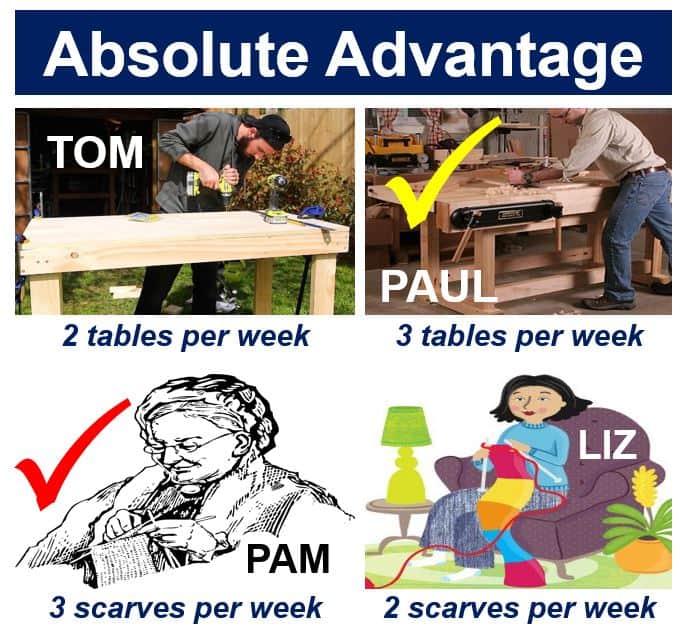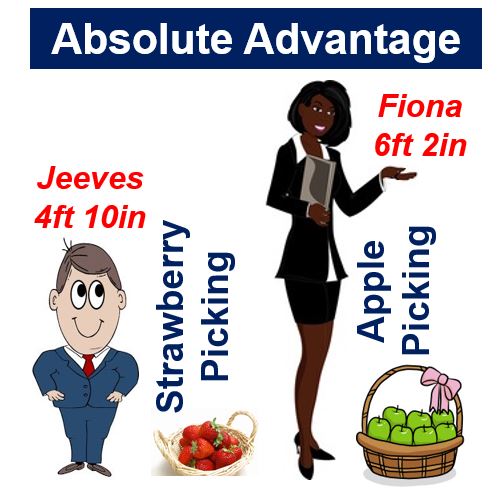Absolute Advantage is the most basic yardstick of economic performance. A country with an absolute advantage can produce something at lower costs than another. That country requires fewer resources to produce the same number of goods as the other country needs.
Panama, a tropical country, can produce bananas much more cheaply than Canada can. Canada would need expensive greenhouses. Panama has an absolute advantage over Canada regarding banana production.
Economies, companies, and people
We use the term for economies, as well as companies and individuals. If I say that John has an absolute advantage over Simon regarding carrying goods, what does it mean? It means John has characteristics that make it easier for him to carry goods – perhaps he’s much stronger and fitter than Simon. Put simply, in this scenario, it means John can move the same amount of stuff at a lower cost (compared to Simon).
Scottish economist and philosopher Adam Smith first used the term absolute advantage over 250 years ago.
For many complicated products, absolute advantage is difficult to measure, because we need to consider several factor inputs.
The Economist says the following regarding absolute advantage: “If one person, firm or country can produce more of something with the same amount of effort and resources, they have an absolute advantage over other producers.”
“Being the best at something does not mean that doing that thing is the best way to use your scarce economic resources. The question of what to specialize in–and how to maximize the benefits from international trade–is best decided according to comparative advantage.”

Comparative vs. absolute advantage
However, if an economy doesn’t have an absolute advantage, should it not be producing that good? Surprisingly, economists say ‘not necessarily.’ An economy with a comparative advantage, however, should be producing it.
Absolute advantage refers to the difference in productivity of nations, companies or individuals. Comparative advantage, on the other hand, refers to higher or lower opportunity costs.
Comparative advantage is the ability of, for example, one economy to produce a particular product or service at a lower marginal and opportunity cost over another.
Opportunity cost refers to the benefit that an economy could have received, but gave up, do something else. In other words, opportunity cost is the difference in the cost between what an economy chooses to do and what it could have done.
Likewise, people looking at opportunity cost think “If I do this, what will I have to give up?”
Absolute and comparative advantage do not necessarily remain the same or change in parallel. Comparative and absolute advantage may evolve differently over time.

Comparative vs. relative advantage
A country’s advantage may be absolute in producing several different goods. However, it is not advisable to try to produce all of them. Ideally, it should focus on goods where it has a relative advantage.
Relative advantage is the ability of one entity to produce something cheap than another entity. When making the comparison, we assume that both entities have the same expenses.
In other words, with the same amount of inputs, one can produce more than the other.
When countries focus on producing goods, where they have a relative advantage, global GDP increases. Consequently, if countries trade with one another, they will all have more goods.
On the other hand, if they try to produce goods for which they do not have a relative advantage, global GDP shrinks.
Examples of absolute advantage
Canada’s agricultural sector
The Canadian economy has an absolute advantage in agricultural goods relative to most other countries globally. This because land is relatively abundant in Canada, as well as low cost.
Chinese manufacturing
China produces and exports low-cost manufactured goods. The country has an absolute advantage because of its considerably lower unit labor costs.
Italy and wine production
In 2022, the US produced 22.4 million hecoliters of wine annually, while Italy produced over 49.8 million hectoliters. Italy has an absolute advantage because it produces each bottle of wine using fewer resources than the US does. Italy’s output is considerably greater than the US’ over the same amount of time.
Mexico and nearshoring
As of October 2023, Mexico is poised to become a significant nearshoring partner for the US, several factors could contribute to Mexico having an absolute advantage in certain sectors or services. Let’s discuss some of the potential reasons:
Geographical Proximity: Mexico shares a border with the U.S., which can significantly reduce transportation costs and time, especially when compared to other offshoring locations like Asia. This proximity also facilitates faster shipping of goods, reducing lead times and inventory costs.
Cultural and Time Zone Alignment: Sharing similar time zones and cultural traits can be a significant advantage in business operations, especially in services like customer support, IT, and other outsourced services. Communication is streamlined, and the coordination of activities becomes more efficient.
Cost Advantage: Mexico often offers lower labor costs compared to the U.S., giving it an absolute advantage in labor-intensive industries. This is especially pertinent for manufacturing industries, such as automotive, electronics, and textiles.
Trade Agreements: The United States-Mexico-Canada Agreement (USMCA), which replaced NAFTA, facilitates trade between the U.S. and Mexico. Such agreements can simplify customs processes, reduce tariffs, and provide a more predictable trade environment.
Skilled Labor Force: Over the years, Mexico has developed a skilled labor force in various sectors, including manufacturing, IT, and services. The availability of skilled workers at a lower cost can give Mexico an absolute advantage over other countries in specific industries.
Infrastructure: Mexico has been investing in its infrastructure, including ports, roads, and telecommunications. Improved infrastructure can make manufacturing and other business operations more efficient.
Supply Chain Integration: Many U.S. companies have already established operations in Mexico, leading to integrated supply chains. When industries become clustered in a particular region, it can lead to efficiencies and specialization, further strengthening the absolute advantage.
An example in carpentry
Imagine there are two carpenters, John and Bill. John can make a table in 10 hours, while Bill can make an identical table in 8 hours. Bill has an absolute advantage over John because it takes him fewer hours to produce the same thing.
However, this does not necessarily mean Bill should be making tables. Bill should then look at his comparative advantage in producing tables, i.e. against other activities. If he can make more money producing chairs, he should focus on being a chair-maker.
Absolute advantage – Adam Smith
Adam Smith (1723-1790) said that nations should specialize in making goods in which they have an absolute advantage. Mr. Smith, a Scottish philosopher, and pioneer of political economy is today’s economists’ father of modern economics.
Mr. Smith first described the principles of absolute advantage in his 1776 publication An Inquiry into the Nature and Causes of the Wealth of Nations. He described it in an international trade context.
When economies specialize and trade, they can move beyond their domestic markets. When an economy moves beyond its borders, it can consequently consume more goods.
Mr. Smith said it isn’t possible for all economies to become rich simultaneously by following mercantilism, because what one country exports another imports.
Instead, all countries would simultaneously gain if they traded freely. Each nation should specialize where they have an absolute advantage.
“What is prudence in the conduct of every private family, can scarce be folly in that of a great kingdom. If a foreign country can supply us with a commodity cheaper than we ourselves can make it, better buy it of them with some part of the produce of our own industry, employed in a way in which we have some advantage. The general industry of the country, being always in proportion to the capital which employs it, will not thereby be diminished….. but only left to find out the way in which it can be employed with the greatest advantage.” – (Adam Smith, The Wealth of Nations, Book IV:2, Modern Library edition)
Specialization in areas of absolute advantage allows economies to allocate resources more efficiently, fostering global economic growth.
Comparative and absolute advantage quotes
In a paper published in the University of Washington website, Prof. Harrington explains Adam Smith’s absolute advantage theory:
“Political and economic liberalism found their expression in Smith’s argument that the wealth of nations depends upon the goods and services available to their citizens, rather than the gold reserves held by the sovereign.”
“Maximizing this availability depends, first, on putting all resources to use, and then, on the ability to obtain goods and services from where they are produced most cheaply (because of ‘natural’ or ‘acquired’ advantages), and to pay for them by production of the goods and services produced most cheaply in the country, with costs measured in terms of direct and “embedded” labor inputs.”
American Nobel laureate Paul Samuelson (1915-2009) was once challenged by American-Polish mathematician Stanislaw Ulam (1909-1984) to “name me one proposition in all of the social sciences which is both true and non-trivial.”
According to the World Trade Organization, it took several years before Samuelson came back with a response, which he suggested was comparative advantage. Regarding comparative advantage, Samuelson said:
“That it is logically true need not be argued before a mathematician; that is not trivial is attested by the thousands of important and intelligent men who have never been able to grasp the doctrine for themselves or to believe it after it was explained to them.”
Do not confuse the term with competitive advantage. Competitive advantage simply refers to the features that give a firm an edge over its competitors regarding a specific good or service. Examples include price, quality, longer-lasting guarantees, credit terms, access to raw materials, and faster delivery times.
“Advantage,” vocabulary and concepts
In business English, there are many compound nouns whose second word is “advantage,” apart from absolute advantage, competitive advantage, and comparative advantage. Let’s have a look at seven more such compound nouns, their meanings, and how we can use them in a sentence.
Pricing Advantage
Offering products at a lower price point.
Example: “The company’s pricing advantage allowed them to dominate the budget smartphone market.”
Technological Advantage
Superiority in tech innovation and application.
Example: “Their technological advantage in battery design has made their electric vehicles highly sought after.”
First-mover Advantage
The benefits gained by the initial significant occupant of a market segment.
Example: “The startup enjoyed a first-mover advantage by launching the first ride-sharing app in the city.”
Strategic Advantage
Gaining an edge through effective planning and resource allocation.
Example: “Our strategic advantage stems from our robust supply chain management.”
Resource Advantage
Having access to superior or more resources.
Example: “The country’s resource advantage due to its rich mineral deposits is undeniable.”
Marketing Advantage
Superiority gained through marketing strategies and brand positioning.
Example: “Their marketing advantage was clear from their highly successful ad campaign.”
Quality Advantage
Providing higher-quality offerings compared to competitors.
Example: “The craftsmanship of their products gives them a quality advantage in the luxury goods sector.”
